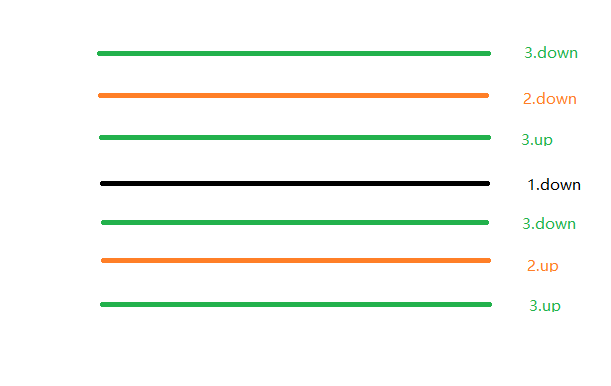昨天在看左程云数据结构视频时遇到一道折纸问题,当时比较感兴趣,并对问题进行分析提取关键点进而通过代码实现。 内容分为:题目描述、问题分析、解决问题和代码描述四大部分。
题目描述
折纸问题
【题目】 请把一段纸条竖着放在桌子上,然后从纸条的下边向上方对折1次,压出折痕后展开。此时 折痕是凹下去的,即折痕突起的方向指向纸条的背面。如果从纸条的下边向上方连续对折2 次,压出折痕后展开,此时有三条折痕,从上到下依次是下折痕、下折痕和上折痕。给定一 个输入参数N,代表纸条都从下边向上方连续对折N次,请从上到下打印所有折痕的方向。 例如:N=1时,打印: down N=2时,打印: down down up
简要说:将纸条从下往上对折N次,由上往下产生的折痕方向序列。
问题分析
对问题进行步骤分析如下:
1. 首先,要对问题进行详细剖析的前提是拿张纸对折几次并从中发现规律。
2. 其次就是进行试验,发现对折1次时折痕为1方向为down,对折2次时折痕为3方向为down down up,对折3次时折痕为7方向为down down up down down up up,对折4次时折痕为15方向为down down up down down up up down down down up up down up up。
3. 最后从结果中找出规律,完成编码。
解决问题
在这里给张图就可以清晰的把问题解决掉。
从结果中分析:第一次折纸后方向为down,第二次折纸后围绕第一次结果从上往下增加了down和up,第三次结果围绕第二次结果(不包括第一次)每个折痕多了down和up。假定我们猜想,通过实验分析和验证第四次结果正确性。明显结果正确,猜想成立。
代码描述
直接上代码:
/*
折纸问题
【题目】 请把一段纸条竖着放在桌子上,然后从纸条的下边向
上方对折1次,压出折痕后展开。此时 折痕是凹下去的,即折痕
突起的方向指向纸条的背面。如果从纸条的下边向上方连续对折
2 次,压出折痕后展开,此时有三条折痕,从上到下依次是下折
痕、下折痕和上折痕。
给定一 个输入参数N,代表纸条都从下边向上方连续对折N次,
请从上到下打印所有折痕的方向。 例如:N=1时,打印: down
N=2时,打印: down down up
*/
#include <iostream>
#include <vector>
#include <string>
#include <iomanip>
using namespace std;
vector<string> origima_problem(int N);
int main(void)
{
int N = 0;
while (cin >> N) {
vector<string> result = origima_problem(N);
cout << "折纸状况(共" << result.size() << ")次:" << endl;
vector<string>::iterator it;
for (it = result.begin(); it != result.end(); ++it) {
cout << setw(5) << *it;
}
cout << endl;
}
}
vector<string> origima_problem(int N) {
vector<string> result, tmp;
string down = "down", up = "up";
for (int i = 1; i <= N; ++i) {
tmp.erase(tmp.begin(), tmp.end());
if (i <= 1) {
result.push_back("down");
continue;
}
for (int i = 0; i < result.size(); ++i) {
if (i % 2 != 0) {
tmp.push_back(result[i]);
}
else {
tmp.push_back(down);
tmp.push_back(result[i]);
tmp.push_back(up);
}
}
result.swap(tmp);
}
return result;
}从代码中,我们可以看出规避了上上一个折痕。这样就达到了预期设想的结果。
思考:如果对折方向发生变化,多个方向会怎么样。
